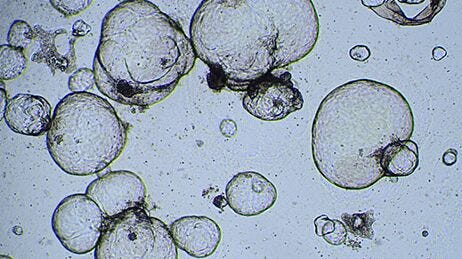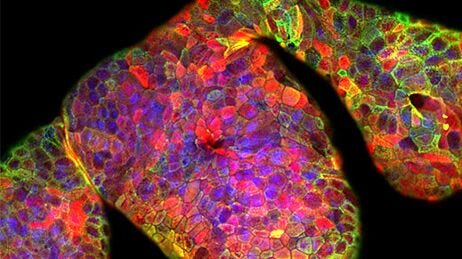How to Perform Albumin Detection Assays in Human Hepatic Organoids
Human hepatic organoids offer a reliable platform for investigating liver function and disease. These physiologically relevant model systems can reduce reliance on animal testing while providing useful insights for various types of studies in medical research. The below protocol describes an albumin detection assay using differentiated human hepatic organoids to study hepatic functionality for drug evaluation studies.
Materials
- HepatiCult™ Organoid Growth Medium (Human) (Catalog #100-0385)
- HepatiCult™ Organoid Differentiation Medium (Human) (Catalog #100-0383)
- Healthy hepatic organoid cultures
- Optional: Antibiotics (e.g. gentamicin)
- Corning® Matrigel® (Corning® Catalog #356231)
- Advanced DMEM/F-12 (Thermo Fisher Catalog #12634010)
- 25% bovine serum albumin (BSA) solution in water
- DMEM/F-12 with 15 mM HEPES (Catalog #36254)
- Optional: Anti-Adherence Rinsing Solution (Catalog #07010)
Preparation
- Expand hepatic organoids in 30 μL Matrigel® domes as described in the Technical Manual (Document #10000008300).
Note: Seeding one full 96-well plate requires 12 - 24 confluent domes in a 24-well plate.
- Warm Corning® 96-well plate in the 37°C incubator overnight.
- Prepare 100 mL of complete HepatiCult™ Organoid Growth Medium (OGM) using the sterile technique as follows:
- Thaw HepatiCult™ Organoid Growth Supplement at room temperature (15 - 25°C) or overnight at 2 - 8°C.
- Combine 95 mL HepatiCult™ Organoid Basal Medium and 5 mL HepatiCult™ Organoid Growth Supplement.
- Optional: Add antibiotics (e.g. 50 μg/mL gentamicin).
- Mix thoroughly. Warm complete HepatiCult™ OGM to room temperature before use.
- Prepare 100 mL of complete HepatiCult™ Organoid Differentiation Medium (ODM) using sterile technique as follows:
- Thaw HepatiCult™ Organoid Differentiation Supplement at room temperature (15 - 25°C) or overnight at 2 - 8°C.
- Combine 95 mL HepatiCult™ Organoid Basal Medium and 5 mL HepatiCult™ Organoid Differentiation Supplement.
- Optional: Add antibiotics (e.g. 50 µg/mL gentamicin).
- Mix thoroughly. Warm complete HepatiCult™ ODM to room temperature before use.
- Prepare 50 mL Wash Buffer as follows:
- Combine 48 mL Advanced DMEM/F-12 and 2 mL 25% BSA solution in water (1% final concentration).
- Mix thoroughly. Keep on ice during use.
- Thaw ~700 µL of Matrigel® on ice to seed one full 96-well plate. This volume includes an extra 20% volume to account for loss during pipetting.
- Thaw CellTiter-Glo® 3D reagent overnight at 2 - 8°C prior to assay day.
- Optional: For the quantification of intracellular albumin, prepare a complete lysis buffer (e.g. MSD lysis buffer with Protease Inhibitor and Phosphatase Inhibitor I added). Keep on ice during use.
Note: Complete lysis buffer needs to be prepared immediately prior to use.
- Optional: Hepatic organoid fragments may adhere to the surfaces of conical tubes and serological pipettes. To minimize adherence, pre-wet the conical tubes with Anti-Adherence Rinsing Solution and Advanced DMEM/F-12 as follows:
- Transfer 5 mL of Anti-Adherence Rinsing Solution to 15 mL conical tubes and 10 mL of Rinsing Solution to 50 mL conical tubes.
- Tighten the lids and swirl tubes to coat. Transfer the Anti-Adherence Rinsing Solution to the remaining tubes, swirling to coat each one.
- Aspirate Anti-Adherence Rinsing Solution from the tubes.
- Repeat the previous steps with 5 mL Wash Buffer for the 15 mL conical tubes and 10 mL of Wash Buffer for the 50 mL conical tubes, then aspirate residual Wash Buffer.
- Cap all coated tubes and store on ice until required.
Protocol
Organoid Dissociation, Seeding, and Differentiation
For setting up hepatic organoids in dome cultures in 96-well plates, refer to the Cytotoxicity Screening Protocol (sections “Organoid Dissociation'' and “Seeding”), with the following modifications.
- To measure the background signal, set up negative control wells consisting of empty Matrigel® domes.
- Perform the last media change 48 - 72 hours before harvest (e.g. on Day 7/8 of differentiation if harvesting on Day 10), using 150 - 200 µL of complete HepatiCult™ OGM or ODM. Optimization is recommended for every donor.
Quantifying Albumin in the Supernatant
Supernatant Collection and Cell Viability Assay:
- On the day of harvest, warm thawed CellTiter-Glo® 3D Reagent to room temperature. Gently mix by inverting.
- Equilibrate the 96-well plate of differentiated organoids to room temperature.
- Without disturbing the domes, transfer the medium in each well (i.e. supernatant) to a round bottom 96-well plate. Proceed to “Albumin Detection” to measure albumin in the supernatant.
Note: If not used immediately, store the supernatant at -20°C for up to 1 month. We recommend aliquoting the samples to avoid multiple cycles of freeze-thaw.
- In a conical tube, mix CellTiter-Glo® 3D Reagent and DMEM/F-12 with 15 mM HEPES at a ratio of 1:1. Invert the tube gently to mix.
- Add 100 µL of CellTiter-Glo® 3D Reagent + DMEM/F-12 with 15 mM HEPES to each well containing a dome.
- Pipette up and down vigorously eight times to lyse the organoids.
- Incubate the plate in the dark for 30 minutes at room temperature.
- Transfer 50 µL of the contents of each well to an opaque white-walled 96-well plate.
- Measure luminescence.
Quantifying Intracellular Albumin
To quantify intracellular albumin, set up separate domes and differentiate the organoids as described in the section “Organoid Dissociation, Seeding, and Organoid Differentiation”.
Cell Lysate Harvest
- On the day of harvest, prepare a complete lysis buffer.
- Aspirate the spent media.
- Add 100 μL of pre-chilled complete lysis buffer to each well containing a dome.
- Pipette up and down vigorously 8 - 10 times to lyse the organoids.
- Incubate the plate on ice for 30 minutes. Proceed to “Albumin Detection”.
Optional: The lysates can be centrifuged to remove any cellular debris.Note: If not used immediately, parafilm the plate and store the lysates at -20°C for up to 1 month. We recommend aliquoting the samples to avoid multiple freeze-thaw cycles.
Albumin Detection
Measure the concentration of the albumin in the supernatant with the desired immunoassay kit, following the supplier-provided protocol.
Analysis
- Fit the standard curve to a four-parametric curve as per the instructions of the kit and interpolate the concentration of albumin.
- Normalize sample albumin concentrations to background/negative controls (e.g. empty Matrigel® domes) and cell quantity.
- For supernatant samples, normalize to their respective CellTiter-Glo® 3D readings.
- For intracellular lysate samples, normalize to total intracellular protein content, measured using a protein quantification kit and the cell lysates used for albumin detection.

Figure 1. Secreted and Intracellular Albumin Levels Increase in a Donor- and Time-Dependent Manner in Human Hepatic Organoids
Organoids from three different donors were differentiated in HepatiCult™ ODM for up to 15 days. (A) Organoids were collected and lysed for intracellular albumin and intracellular total protein quantity assessments at different time points during organoid culture in HepatiCult™ OGM and ODM. (B) Organoid supernatant was also collected at the same time points and matched organoids were lysed for viability assessments. Both intracellular and secreted albumin levels were measured using the MSD R-PLEX Human Albumin Assay and found to increase as human hepatic organoids undergo differentiation in a donor- and time-dependent manner. N = 3 donors, mean values from 2 experiments. Error bars = SD. One-way ANOVA with Tukey multiple comparisons test used for statistical testing (single asterisk indicates P < 0.05, double asterisk indicates P ≤ 0.005, triple asterisk indicates P ≤ 0.0005).
Request Pricing
Thank you for your interest in this product. Please provide us with your contact information and your local representative will contact you with a customized quote. Where appropriate, they can also assist you with a(n):
Estimated delivery time for your area
Product sample or exclusive offer
In-lab demonstration






